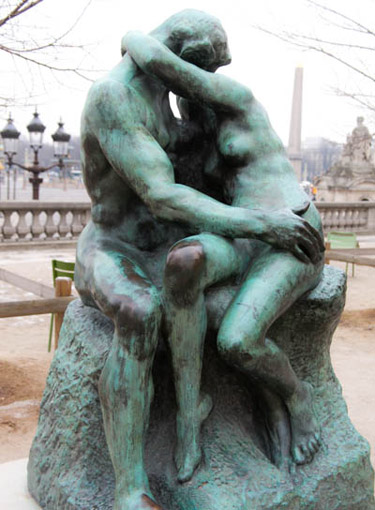Artist:
August Rodin
Title:
Le Baiser, The Kiss
Year:
1889
Adress:
Jardin des Tuileries
www.musee-rodin.fr:
The Kiss originally represented Paolo and Francesca, two characters borrowed, once again, from Dante’s Divine Comedy: slain by Francesca’s husband who surprised them as they exchanged their first kiss, the two lovers were condemned to wander eternally through Hell. This group, designed in the early stages of the elaboration of The Gates, was given a prominent position on the lower left door, opposite Ugolino, until 1886, when Rodin decided that this depiction of happiness and sensuality was incongruous with the theme of his vast project.
He therefore transformed the group into an independent work and exhibited it in 1887. The fluid, smooth modelling, the very dynamic composition and the charming theme made this group an instant success. Since no anecdotal detail identified the lovers, the public called it The Kiss, an abstract title that expressed its universal character very well. The French state commissioned an enlarged version in marble, which Rodin took nearly ten years to deliver. Not until 1898 did he agree to exhibit what he called his 'huge knick-knack' as a companion piece to his audacious Balzac, as if The Kiss would make it easier for the public to accept his portrait of the writer.
www.wikipedia.org:
The sculpture, The Kiss, was originally titled Francesca da Rimini, as it depicts the 13th-century Italian noblewoman immortalised in Dante's Inferno (Circle 2, Canto 5) who falls in love with her husband Giovanni Malatesta's younger brother Paolo. Having fallen in love while reading the story of Lancelot and Guinevere, the couple are discovered and killed by Francesca's husband. In the sculpture, the book can be seen in Paolo's hand. The lovers' lips do not actually touch in the sculpture, suggesting that they were interrupted and met their demise without their lips ever having touched.
When critics first saw the sculpture in 1887, they suggested the less specific title Le Baiser (The Kiss).
Rodin indicated that his approach to sculpting women was of homage to them and their bodies, not just submitting to men but as full partners in ardor. The consequent eroticism in the sculpture made it controversial. A bronze version of The Kiss (74 centimetres (29 in) high) was sent for display at the 1893 World's Columbian Exposition in Chicago. The sculpture was considered unsuitable for general display and relegated to an inner chamber with admission only by personal application.
The Kiss originally represented Paolo and Francesca, two characters borrowed, once again, from Dante’s Divine Comedy: slain by Francesca’s husband who surprised them as they exchanged their first kiss, the two lovers were condemned to wander eternally through Hell. This group, designed in the early stages of the elaboration of The Gates, was given a prominent position on the lower left door, opposite Ugolino, until 1886, when Rodin decided that this depiction of happiness and sensuality was incongruous with the theme of his vast project.
He therefore transformed the group into an independent work and exhibited it in 1887. The fluid, smooth modelling, the very dynamic composition and the charming theme made this group an instant success. Since no anecdotal detail identified the lovers, the public called it The Kiss, an abstract title that expressed its universal character very well. The French state commissioned an enlarged version in marble, which Rodin took nearly ten years to deliver. Not until 1898 did he agree to exhibit what he called his 'huge knick-knack' as a companion piece to his audacious Balzac, as if The Kiss would make it easier for the public to accept his portrait of the writer.
www.wikipedia.org:
The sculpture, The Kiss, was originally titled Francesca da Rimini, as it depicts the 13th-century Italian noblewoman immortalised in Dante's Inferno (Circle 2, Canto 5) who falls in love with her husband Giovanni Malatesta's younger brother Paolo. Having fallen in love while reading the story of Lancelot and Guinevere, the couple are discovered and killed by Francesca's husband. In the sculpture, the book can be seen in Paolo's hand. The lovers' lips do not actually touch in the sculpture, suggesting that they were interrupted and met their demise without their lips ever having touched.
When critics first saw the sculpture in 1887, they suggested the less specific title Le Baiser (The Kiss).
Rodin indicated that his approach to sculpting women was of homage to them and their bodies, not just submitting to men but as full partners in ardor. The consequent eroticism in the sculpture made it controversial. A bronze version of The Kiss (74 centimetres (29 in) high) was sent for display at the 1893 World's Columbian Exposition in Chicago. The sculpture was considered unsuitable for general display and relegated to an inner chamber with admission only by personal application.



